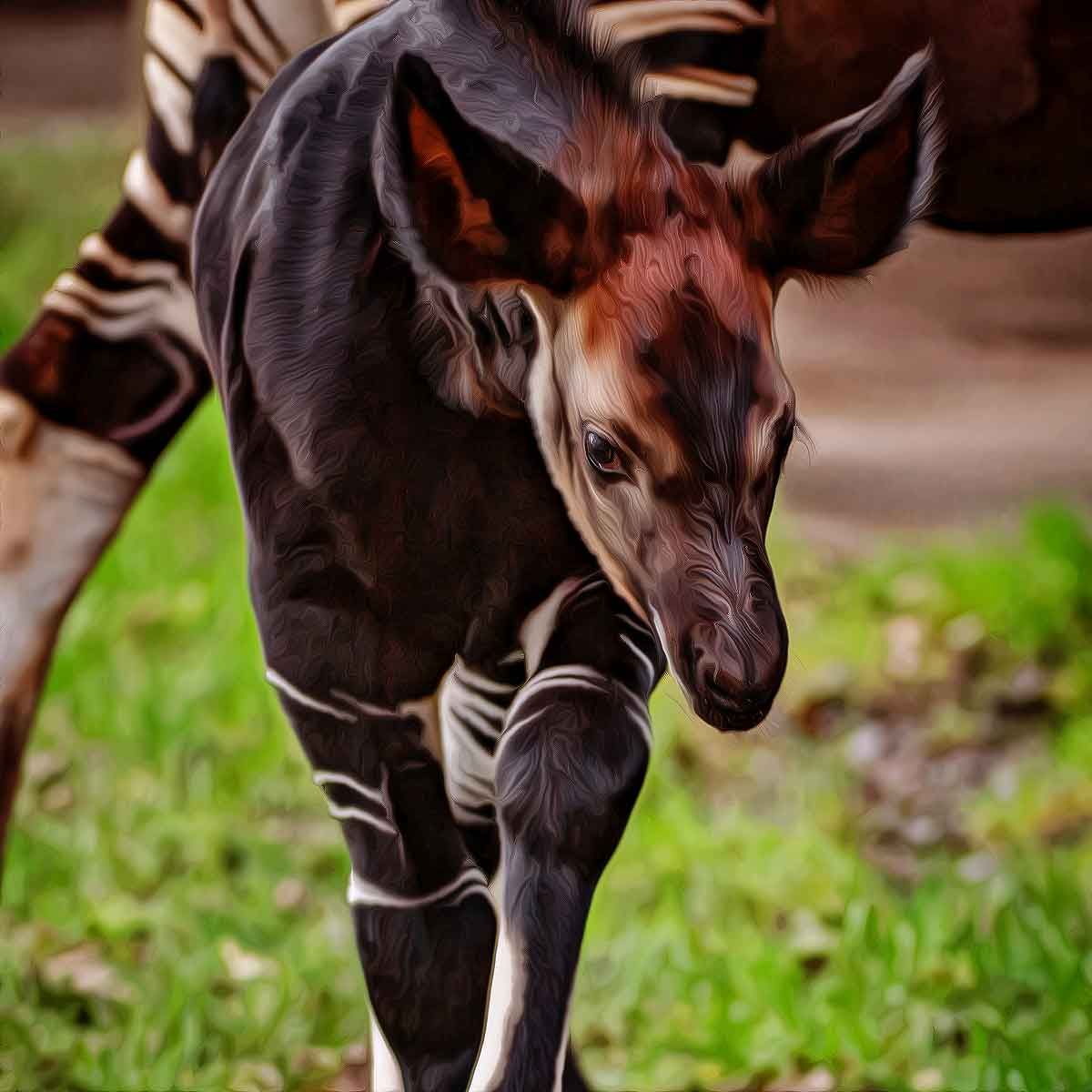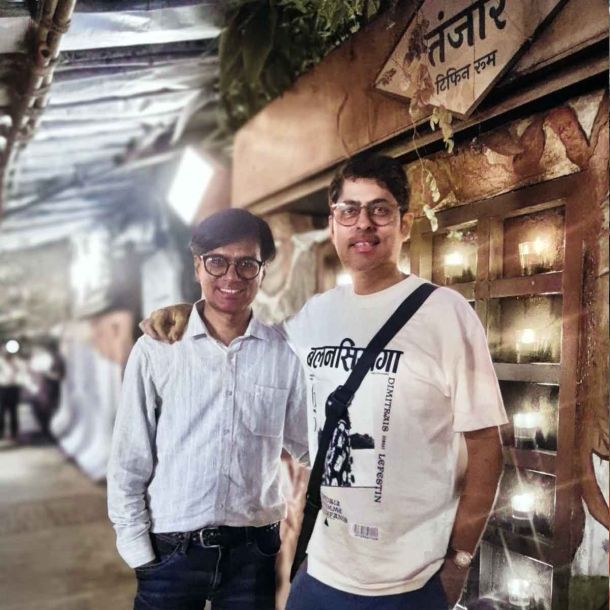More Coverage
Twitter Coverage
Satyaagrah
Written on
Satyaagrah
Written on
Satyaagrah
Written on
Satyaagrah
Written on
Satyaagrah
Written on
JOIN SATYAAGRAH SOCIAL MEDIA
“You can’t make a zebra by painting stripes on a horse”: Deep in the heart of Congo is a curious creature bit like a horse, a bit like a giraffe "Okapi", an artiodactyl mammal that is endemic to Africa, the Okapi is to the Congo what the Panda is to China

The okapi (Okapia johnstoni) is a mammal of the Ituri Rainforest in central Africa. Although it bears striped markings reminiscent of the zebra, it is most closely related to the giraffe.
The resemblance it bears to both the zebra and giraffe led some to believe it is a cross between the two, but despite the appearance of certain similarities, it is in fact not closely related to the zebra. Native just to the Ituri forests situated in the northeast of the Democratic Republic of the Congo, it was known only to the local people until 1901.
|
Characteristics
Okapis have dark bodies, with striking horizontal white stripes on the back legs, making them resemble zebras from a distance. These markings are thought to be "follow me" markings intended to help young follow their mothers through the dense rainforest, and also serve as camouflage. The body shape is similar to that of the giraffe, except that okapis have much shorter necks. Both species have very long (approx. 30 cm or 12 inches), flexible, blue tongues that they use to strip leaves and buds from trees. The tongue of an okapi is long enough for the animal to wash its eyelids and clean its ears: it is one of the few mammals that can lick its own ears. Male okapis have short, skin-covered horns called " ossicones". They have large ears which help them detect their predator, the leopard.
Okapis are 1.9 to 2.5 m (8.1 ft) long and stand 1.5 to 2.0 m (6.5 ft) high at the shoulder. They have a 30 to 42 cm (12 to 17 in) long tail. Their weight ranges from 200 to 250 kg (465 to 550 lb).
In addition to tree leaves and buds, okapis eat grass, ferns, fruit, and fungi. Many of the plant species fed upon by the okapi are known to be poisonous to humans. Examination of okapi feces has revealed that the charcoal from trees burnt by lightning is consumed as well. Field observations indicate that the okapi's mineral and salt requirements are filled primarily by a sulfurous, slightly salty, reddish clay found near rivers and streams.
Okapis are largely diurnal and essentially solitary, coming together only to breed. and forage along fixed, well-trodden paths through the forest. Okapis occur alone or in mother-offspring pairs. They have overlapping home ranges of several square kilometers and typically occur at densities of about 0.6 animals per square kilometer. The home ranges of males are generally slightly larger than those of females. Although they are not social animals, okapis tolerate each other in the wild and may even feed in small groups for short periods of time.
Only one infant is born at a time, between August and October, weighing between 14 to 30 kg (30 and 65 lb). Their life span in captivity ranges from 15 to over 30 years, but data from wild populations is unavailable. Okapi courtship and mating rituals are known only from observations done in zoos. Partners begin courtship by circling, sniffing, and licking each other. Eventually, the male asserts his dominance by extending his neck, tossing his head, and thrusting one leg forward. This display is followed by mounting and copulation. After mating, the male and female parts. The gestation period lasts about 440 days, and females retreat into dense forest vegetation to give birth. They are precocial and may nurse after 21 minutes and attempt to stand after just 16 minutes. Young spend the first day or two of life following their mother around and exploring the environment. After this, they find a suitable hiding spot and make a nest. For the next two months, they spend 80% of their time in this nest. Hiding behavior appears to promote rapid growth and provides protection from predators. A disturbed calf lies motionless in its nest, and a female okapi will rush to aggressively defend her calf from danger. During the hiding stage, young nurses relatively infrequently and do not defecate. These strategies help keep them undetected by predators. Weaning occurs at about 6 months, although young may continue to suckle for more than a year. Young males begin developing horns at one year of age, and both males and females reach adult size at about three years. In captivity, the youngest female to breed was 1 year 7 months old, and the youngest male was 2 years 2 months old.
Okapis have several methods of communicating their territory, including scent glands on each foot that leave behind a tar-like substance that signals their passage, as well as urine marking. Males are protective of their territory but allow females to pass through their domain to forage.
Okapis prefer altitudes between 500 and 1,000 m, although they may venture above 1,000 m in the eastern montane rainforests. The range of the okapi is limited by high montane forests to the east, swamp forests below 500 m to the west, savannas of the Sahel/Sudan to the north, and open woodlands to the south. Okapis are most common in the Wamba and Epulu areas.
The okapi is the symbol of cryptozoology.
|
History
The okapi was known to the ancient Egyptians; shortly after its "discovery" by Europeans, an ancient carved image of the animal was discovered in Egypt. For years, Europeans in Africa had heard of an animal that they came to call 'the African unicorn'. In his travelogue of exploring the Congo, Henry Morton Stanley mentioned a kind of donkey that the natives called the 'atti', which scholars later identified as the okapi. Explorers may have seen the fleeting view of the striped backside as the animal fled through the bushes, leading to speculation that the okapi was some sort of rainforest zebra. When the British governor of Uganda, Sir Harry Johnston, discovered some pygmy inhabitants of the Congo being abducted by a German showman for exhibition in Europe, he rescued them and promised to return them to their homes. The grateful pygmies fed Johnston's curiosity about the animal mentioned in Stanley's book. Johnston was puzzled by the okapi tracks the natives showed him; while he had expected to be on the trail of some sort of forest-dwelling horse, the tracks were of some cloven-hoofed beast. Though Johnston did not see an okapi himself, he did manage to obtain pieces of striped skin and eventually a skull. From this skull, the okapi was correctly classified as a relative of the giraffe; in 1902, the species was formally recognized as Okapia johnstoni. The first live specimen in Europe arrived in Antwerp in 1918. The first okapi to arrive in North America was at the Bronx Zoo, via Antwerp, in 1937. The first okapi born in captivity was at Brookfield Zoo in Illinois, which directs the okapi Species Survival Plan for the American Zoo and Aquarium Association. Okapi are now reasonably common in zoos around North America and Europe. Immediately following their discovery, zoos around the world attempted to obtain okapis from the wild. These initial attempts were accompanied by a high mortality rate due to the rigors of traveling thousands of miles by boat and by train. In more recent years, shipment by airplane has proven more successful.
Status
Although okapis are not classified as endangered, they are threatened by habitat destruction and poaching. Conservation work in the Congo includes the continuing study of okapi behavior and lifestyles, which led to the creation 1992 of the Okapi Wildlife Reserve. The Congo Civil War threatened both the wildlife and the conservation workers in the Reserve.
On June 8, 2006, scientists reported that evidence of surviving okapis in Congo's Virunga National Park had been discovered. This had been the first official sighting since 1959, after nearly half a century.
On September 27, 2006, an okapi named Sauda (meaning "dark beauty" in Swahili), was born at the Brookfield Zoo in Illinois.
Etymology
The genus name Okapia derives from the native name o'api, while the species epithet (johnstoni) is in recognition of the explorer Sir Harry Johnston, who organized the expedition that first acquired an okapi specimen for science from the Ituri Forest in the Democratic Republic of the Congo. This is the only place where an okapi can be found in the wild.
|
Trivia
- The obscurity of the okapi led the International Society for Cryptozoology to adopt it as an emblem.
- In the original Hitch Hiker's Guide to the Galaxy radio series, Arthur Dent's brother was said to have been nibbled to death by an okapi. The exact circumstances that brought this fate about were left unclear.
- The Microsoft Computer Game " Zoo Tycoon" allows the creation of an okapi exhibit, and one of the scenarios deals with the birth of a baby okapi.
References:
 Support Us
Support Us
Satyagraha was born from the heart of our land, with an undying aim to unveil the true essence of Bharat. It seeks to illuminate the hidden tales of our valiant freedom fighters and the rich chronicles that haven't yet sung their complete melody in the mainstream.
While platforms like NDTV and 'The Wire' effortlessly garner funds under the banner of safeguarding democracy, we at Satyagraha walk a different path. Our strength and resonance come from you. In this journey to weave a stronger Bharat, every little contribution amplifies our voice. Let's come together, contribute as you can, and champion the true spirit of our nation.
 |  |  |
| ICICI Bank of Satyaagrah | Razorpay Bank of Satyaagrah | PayPal Bank of Satyaagrah - For International Payments |
If all above doesn't work, then try the LINK below:
Please share the article on other platforms
DISCLAIMER: The author is solely responsible for the views expressed in this article. The author carries the responsibility for citing and/or licensing of images utilized within the text. The website also frequently uses non-commercial images for representational purposes only in line with the article. We are not responsible for the authenticity of such images. If some images have a copyright issue, we request the person/entity to contact us at This email address is being protected from spambots. You need JavaScript enabled to view it. and we will take the necessary actions to resolve the issue.
Related Articles
- In one of the rarest incidents wild mother elephant gave birth to twins in the Bandipur Tiger Reserve: Soon after the birth, the two toddlers joined their mother back in the herd
- “By discovering nature, you discover yourself”: Guide Anuradha Rao at Ross Island interacts with Animals, People from all over the world come to witness it, She is also one of the lucky survivors of the tsunami that devastated Andaman & Nicobar in 2004
- “If it looks like a duck, quacks like a duck, it's a duck”: Mandarin duck is considered one of the most beautiful birds in the world, this is because of its stunning plumage, which is made up of an array of colors that you can't help but notice them
- "An animal's eyes have the power to speak a great language": Shoebill - large, elusive, stalk-like bird with prehistoric appearance due to oversized shoe-shaped beak, usually silent but clatter their bills loudly during greetings sounds like a machinegun
- “An animal’s eyes have the power to speak a great language”: Rare Himalayan Lynx found in Ladakh region of India, they occur throughout northern slopes of Himalayas and has been reported both from thick scrub woodland & barren, rocky areas above tree line
- “Birds teach a great life lesson. All you have to do is listen to their song”: Chilika in Odisha is the largest brackish water lake in Asia and great attraction for tourists for fishing, bird watching & boating, indigenous & migratory birds are a delight
- "Car shed is the ‘brain center' for the safety and operation of a metro rail": Aaditya Thackeray claimed that metros go to car shed only once in 2-3 months, Metro Man E Sreedharan Fact Checks Aaditya Thackeray on Aarey claims
- "A mystic Himalayan Griffon is a bird who separates heaven and earth with his wings": A rare vulture was captured in Eidgah cemetery of Kanpur's Colonelganj, locals handed it over to Forest Department after capturing it, had been there for a week
- "There is no index of character so sure as the voice": Pahadi Mayna of Chhattisgarh reproduce an exact pronunciation as humans at times, it begin to learn human speech sounds under social relationships, for bird to talk you must intrude on its social life
- “A river seems like a magic thing, moving, living part of the earth itself”: India to gain a huge boost in inland water transportation by launching the world's Longest River Cruise, MV Ganga Vilas, sailing from Varanasi to Dibrugarh across 27 river system
- National Geographic unveils Odisha’s Similipal black tiger on its October 2025 cover as Naveen Patnaik hails Prasenjeet Yadav’s 120-day mission capturing this rare wonder
- "Everything depends on this: a fathomless sinking into a fathomless nothingness": Joshimath sinking - 10 crore people visit Uttarakhand a year, how much can it take say experts, Nainital, Mussoorie, Dharchula and several towns could face similar disaster
- “You need mountains, long staircases don’t make good hikers”: Kalavantin Durg - one of the steepest fortresses in Maharashtra 2,300 feet high trek up this fort is called ‘Climb to Heaven’ because it involves rugged terrain & climbing narrow rock-cut steps
- “Kerala is superbly seen from a saddle, or with a paddle. No hour of life is wasted there”: Alleppey, also known as Alappuzha, a picturesque town of #Kerala famous for its backwaters and serene beauty has fascinated tourists for its floating houses
- “Someone is sitting in the shade today because someone planted a tree a long time ago”: Great banyan tree in Kolkata's Botanical Garden is world's widest tree with 3600 aerial roots spread in 156000 sqfeet area gives an impression of thick patch of forest




























